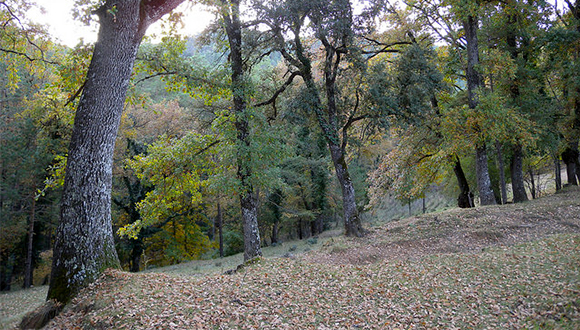Forest management in Europe will not stop global warming

Aude Valade, CREAF researcher, and the international team behind the study published in Nature recommends that forests be managed with a view to preserving the ecological, social and cultural ecosystem services they provide, rather than to cooling the planet as envisaged in the Paris Agreement.

The Paris Agreement includes a commitment to sustainable forest management as a means of putting the brakes on global warming. A forest can be managed in such a way as to increase its activity, its growth and the amount of atmospheric carbon dioxide (CO2) it needs for photosynthesis. It was previously thought that CO2 levels in the atmosphere would fall, or at least stop rising, if forests were to absorb more of the gas. However, a new study published today in Nature reveals that focusing the management of Europe's forests on halting global warming will not affect the climate appreciably. Aude Valade, a CREAF researcher with a Marie Skłodowska-Curie grant, is a member of the international team of scientists who conducted the study. They improved a highly complex model for calculating the amount of carbon, energy and water trapped or released according to how forests are managed, and used it to compare three strategies that represent the different forest management methods being applied in Europe to mitigate climate change.
Three strategies that represent the different forest management methods being applied in Europe to mitigate climate change.
None of the strategies fulfils all three of the objectives established to stop climate change, namely maximizing carbon sequestration, increasing forest albedo and reducing the near-surface air temperature.
Europe's dilemma: lower temperature or more wood?
Management geared to maximizing atmospheric carbon capture would mean turning deciduous forests into coniferous forests and increasing the proportion of unmanaged forests. Using their computational model, the researchers calculated that this strategy would remove 7 Pg of carbon from the atmosphere by around 2100. In isolation, such a reduction in carbon could evidently bring temperatures down, but the strategy has other effects that must be taken into account too. As Valade explains, "switching from deciduous trees to conifers could improve a forest's CO2 sequestration capacity but might also alter its microclimate, with changes in wind speed, atmospheric humidity, cloud formation and albedo, i.e. the percentage of radiation the forest can absorb based on the colour of its surface". So, despite the strategy boosting carbon sequestration, its side effects would warm the environment, resulting in practically no change in temperature and, according to the model, a 12% drop in wood production.

Management aimed at cooling the planet's surface, meanwhile, would entail turning coniferous forests into deciduous forests and increasing the proportion of managed shrubland. This would reduce spring temperatures in Scandinavia and the Alps by 0.3ºC, but would have no noticeable effect globally. Additionally, it would see wood production decrease by 25%.
Management targeting an increase in albedo would involve turning coniferous forests into deciduous forests and reducing the proportion of managed high forest. This would help reflect more solar radiation, but would have no effect overall because it would also alter cloud formation, atmospheric humidity and wind circulation, and the surface would get hotter. Furthermore, no more CO2 would be sequestered than with the current form of management and wood production would fall by 30%.
The study's results show that sustainable forest management's climate benefits are modest and local.
The study's results show that sustainable forest management's climate benefits are modest and local. Its authors thus suggest that the priority for forest management in Europe over the coming decades should not be mitigating climate change but rather adapting forests to such change to preserve the ecological, social and cultural services and goods they provide.
Article: Luyssaert, S., Marie, G., Valade, A., Chen, Y.-Y., Njakou Djomo, S., Ryder, J., Juliane, O., Naudts, K., Lansø, A.S., Ghattas, J., & McGrath, M.J. (2018). Tradeoffs in using European forests to meet climate objectives. Nature, http://dx.doi.org/10.1038/s41586-018-0577-1
Related news

IPBES publishes two reports to transform the way we engage with nature, conserve it and survive




